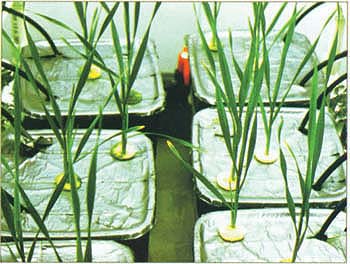All Issues
Carbon dioxide hampers nitrate incorporation by plants
Publication Information
California Agriculture 56(3):84-85.
Published May 01, 2002
PDF | Citation | Permissions
Full text
Nitrate fertilizer is not nearly as efficient as ammonium fertilizer when atmospheric carbon dioxide levels are unusually high, according to a study by two UC Davis professors.
Rising levels of atmospheric carbon dioxide — associated with global warming — can interfere with a plant's ability to incorporate nitrogen, Arnold Bloom and David Smart reported in the Feb. 5 Proceedings of the National Academy of Sciences. Carbon dioxide concentrations have increased by an estimated 30% during the past two centuries and are likely to double during the next century.
Farmers and gardeners commonly apply nitrogen-rich fertilizers to their crops in order to enhance yields. The UC Davis scientists studied how wheat plants respond to being fertilized with two different forms of nitrogen, nitrate and ammonium, under varying concentrations of atmospheric carbon dioxide.
The plants receiving ammonium responded much more to the increased carbon dioxide than did the plants receiving nitrate, the scientists found. Elevated carbon dioxide levels inhibited the processing of nitrate in the wheat leaves. When atmospheric carbon dioxide rose to nearly twice the normal level, the leaves of plants receiving ammonium increased in size by nearly 49%, while plants receiving nitrate increased by only 24%.
Additionally, the protein content of the wheat plants receiving ammonium increased 73% under elevated carbon dioxide, compared to only 32% for those receiving nitrate, suggesting that rising atmospheric carbon dioxide levels might diminish the nutritional quality of grain receiving nitrate fertilizer. The work has since been repeated in tomatoes, with similar results.
"We expect that the data will have real-world implications for crop production," Bloom says. "In well-drained soils generally devoted to wheat production, nitrate is the common form of nitrogen available. The study suggests that a shift to increase ammonium availability might be needed."
Furthermore, plant and tree species in natural ecosystems that depend on nitrate conversion into amino acids in their leaves are likely to be at a competitive disadvantage with those species that are either able to convert nitrate into amino acids in their roots or use ammonium as their predominant nitrogen source. "This may result in significant changes in the distribution of plants in the wild as atmospheric carbon dioxide levels continue to rise," Bloom says.
Wheat was grown in a controlled environmental chamber under elevated carbon dioxide. Plants received ammonium (left) or nitrate (right) as their sole nitrogen source. Leaves of plants receiving nitrate are yellowish-green, signaling that they are not assimilating the nutrient as well as plants receiving ammonium.





